-

人教版新目标初中英语八年级上册I’m more outgoing than my sister教案2篇
1 交通工具的比较此活动为小组活动。学生通过讨论找出到达某一城市可乘坐的各种交通工具,并选择最佳出行方式。Teacher:We’re going to Shanghai. How many ways can we use to get there? Yes, there are four ways: by bus, by plane, by train, by ship. Please discuss how you are going to get there.操作建议:(1)学生以小组为单位展开活动,谈论本组所选择的交通工具。(2)各组选代表向全班汇报,阐述本组所选择的交通工具的利和弊。完成任务所需要的语言结构:We can go there by ship. It’s more comfortable and cheaper than any other transportation.We can go there by bus. It’s cheaper but it takes longer time.2 哪个城市更合适?此活动具有挑战性。假设中国要举行2014年世界杯足球赛,分别从历史,人文,天气等方面对各城市(北京,大连,上海,昆明)进行比较,选择最佳举办城市。T: Imagine China is holding the 2014 FIFA World Cup. Which city do you think is the best for the World Cup, Beijing, Dalian, Shanghai or Kunming? Let’s work in groups. If you choose Beijing, please join the Team Red. If you chose Dalian, please join the Team White. If you choose Shanghai, please join the Team Blue. If you choose Kunming, please join the Team Green. Please show us its advantages. Then let’s see which team will win.

人教版新目标初中英语八年级上册What’s the best radio station教案2篇
教学重点和难点:运用所掌握的语言描述,比较不同地点的特点。在练习中学习掌握英语比较级和最高级的用法。课前准备分配小组,每组五至六人。通过上网或翻阅报刊杂志等方法,确定旅游线路,做出基本的旅游计划。教学设计:本节课流程图 学法指导:1.由于这是一堂新课,在教学中应注意面向全体,发挥学生的主体性,引导学生积极参与,激发学生的求知欲和学习积极性,指导学生积极思维,主动获取知识,养成良好的学习方法。逐步学会独立解决问题。总之要尽可能调动学生的非智力因素促进智力因素的发展。教法选择:1.电化教学法2.课堂讨论法3.任务型教学法采用这些方法的目的是为了充分调动学生的学习积极性,使学生变被动学习为主动学习。通过电脑形象的演示,加强印象,提高兴趣,突破难点,提高教学效率,进而增大教学的容量和信息量。充分体现教师为主导,学生为主体的教学原则。

人教版新目标初中英语八年级上册What’s the matter教案2篇
She shouldn’t go to the party tonight.Step7. TaskT: You know, there are lots of problems in our life. If you are a doctor, please tell us how to solve the problem. I will divide you into 9 groups. Please work in groups. And then choose one of you to report your ideas.The following are the problems:I have a toothache.I am hungry. I have a sore throat.I am stressed out. I have a sore back.I am tired. I can’t sleep.I have a cold. I have a headache.Report: If you have a headache, you should go to bed early. You should see the doctor. You should eat some medicine. You shouldn’t wash your face with cold water.You shouldn’t sleep late.You shouldn’t swim.…..T encourages the students to give advice as much as possible.Homework:1. Chose one of the problems, and write down your advice2. Copy the new words这一步是用于热身的,同时也可以让他们复习一部分的表示人体部位的单词,扩充知识.学习语言的过程也是一个不断积累的过程,复习旧知识,增添新知识.通过小游戏,强化学生对Does she/he have…这个句子的运用能力.通过复习,自然的引到下面新知识的学习。充分利用表格,由句子到对话,再到文章,让学生循序渐进. 提高学生的综合语言运用能力,运用以前学过的知识来解决身边的问题.Period 5 (Section B 3a—3c, selfcheck)教学内容与分析:

人教版新目标初中英语八年级下册He said I was hard-working教案2篇
This activity introduces some new vocabulary and provide oral practice using the target language.Task 1 . Ask four students to stand in front of the class, and the teacher asks them the following questions as a reporter.1.What are you going to do when you grow up?2.What are you going to do next week?3.What are going to do after school?The students will give different answers, then ask a good student to report what they said.I am going to e a doctor.What did she say?----------She said she was going to be a doctor.I am going to have a party on Friday night.What did he say?-------He said he was going to have a party on Friday night.I am going to do my homework.What did she say ?------ She said she was going to do her homework.I am going home after school.What did she say?-----She said she was going home after school.Say In this unit we are going to learn to use words like to report what someone said.Task 2. Read the instructions. Then ask a student to read the four questions. And write the words on the Bb. Explain what soap opera is.Task 3. Ask the students to Look at the pictures, point out the TV screens in the picture. Ask one girl to read what Marcia said.What did Marcia say? She said She said she was having a surprise party for Lana on Friday night. Repeat the other pictures in the same way.Activity3. Listen and number the pictures in activity 1a.

人教版新目标初中英语八年级下册How long have you been collecting shells教案2篇
Step Ⅱ Show the new words on the screen and teach the new words. Read the new words to students and ask them to repeat.Step Ⅲ 3aThis activity introduces new vocabulary and provides reading practice using the target language.In this activity first look at the four pictures.T: What can you see in the pictures?Ss: Four snow globes.T: Right. There are four snow globes in the pictures. And what are they?Ss: They are a monster, two polar bears, two penguins and a birthday cake.Write these words on the blackboard: snow globe; monster; polar bear; penguin and birthday cake. Read them to the class and ask students to repeat each one. Make sure students understand each word.Use a computer to show the E-mail message on the screen and read the message to students.Get students to read the e-mail on their own, and then draw lines connecting each snow globe and its description.Correct the answers.AnswersA line should connect each snow globe picture with the words that describe it in the letter.Step Ⅳ 3bThis activity provides writing practice using the target language.First review Activity 2a on Page 47.Then ask students to complete the message according to Activity 2a.Some partial sentences are given to students. Write about one person's collection.When students work, walk around the room checking the progress and offering help as needed.When they finish, ask some students to read their messages to the class.

人教版新目标初中英语八年级下册What were you doing when the UFO arrived教案2篇
(一).知识方面: 1.培养学生能运用过去进行时来描述、谈论过去某个时间正在发生的事情或动作的意识和能力,能就过去某个时间正在发生的动作做出正确的描述。 2.培养学生的想象力和角色扮演的合作能力。 3.培养学生讲述过去发生的事情经过的能力。能正确运用一般过去时来讲述故事。 (二).技能方面: 1.本单元的语言目标是Talk about past events and tell a story(谈论过去的时间和讲述一个故事),围绕这一目标,要涉及句型: What were you doing when the UFO arrived? ----I was sitting in the barber’s chair. The barber was cutting my hair. 因此必须学习standing、studying、cleaning、sleeping、cooking、making、eating、cutting、等表示地点的词,以便为上述句型提供语言材料。2.学习过去进行时的有关知识。Was/were+现在分词,是该时态的表达式。 3.在学习过程中,要区分The boy was walking down the street when the UFO landed.和While the boy was walking down the street, the UFO landed.这两种由when和while引导的状语从句的句型结构。注意它们的不同。

人教版新目标初中英语九年级上册Teenagers should be allowed to choose their own clothes教案2篇
Step 1 Greeting Greet the class and check the homeworkStep 2 A duty report The S on duty gives a report on the rules in his home and lead in 3a “Sun Fei’s and Wu Yu’s rules” Step 3 ReadingSs read the conversation and write the two girls’ rules in the chart. Check the answers.Get Ss to read after the tape and then read aloud by themselves. Then, T explains the language points.Step 4 Pairwork 3bRole play. Use the information in chart to practice with the conversation in 3a covered. They can look at the sample conversation in the right box.Step 5 Task 2 “Who’s the best reporter?”Make a survey by asking any 5 students the questions in the chart in activity 4. Then give out a report about it. See who is the best reporter? And the best reporter will get a nice ball-pen.Step 6 Summary and homework:Write out the report in your exercise-books.Period ThreeStep 1 Greeting and a duty reportThe S gives a duty report talking about his experience of being late for school. Lead in the question “Do you ever get to school late? How often do you get to school late? Always, usually, sometimes, or never?Step 2 1a Get Ss to finish writing.Step 3 Pairwork 1b Get Ss to talk about their answers with their partners using the sample conversation in the box on the right.Step 4 Listening practice2a Lead-in: What will happen if you get to school late? What about Peter? Let’s listen to a conversation between Peter and his father. Get Ss to finish 2a (As usual, for the first time, Ss only listen.) Check the answers.

人教版新目标初中英语九年级上册Where would you like to visit教案2篇
The First PeriodⅠ.Teaching Aims and DemandsKnowledge Objects(1) Key Vocabularytiring, educational, fascinating, thrilling, peaceful, exotic, trek, jungle, take it easy, explore, historic, site(2) Target LanguageWhere would you like to go on vacation?I’d like to trek through the jungle, because I like exciting vacations.2. Ability Objects(1)Train students to talk about places they would like to visit with the target language.(2)Train students to describe vacations with different adjectives.(3)Train students' listening skill.3. Moral Object,It′s more interesting to go on vacating somewhere instead of staying at home.Ⅱ. Teaching Key Points1. Key Vocabularytiring, educational, fascinating, thrilling, peaceful, exotic, trek, jungle, take it easy, explore, historic, site2. Target LanguageTalk about different places with the target language.Ⅲ. Teaching Difficult Points1. Describe vacations with different adjectives.2. Talk about different places with the target language.Ⅳ. Teaching Methods1. Teaching by illumination2. Teaching by doing chain drills3. Teaching by pairworkⅤ. Teaching Aids1. A tape recorder2. Some pictures of different places with famous views

人教版新目标初中英语九年级下册We’re trying to save the manatees教案2篇
本单元主要围绕着有关濒临灭绝的动物这一话题,学习了应该怎样保护我们的环境,以及就某一问题展开辩论。目标提示语言目标能够运用所学知识,就某一问题展开辩论。认知目标1、复习一些语法:现在进行时、一般现在时、用used to 表示一般过去时、现在完成时、一般过去时的被动语态。2、学会表达同意和不同意。3、学会以下基本句型:We’re trying to save the manatees.Manatees eat about 100 pounds of food a day.There used to be a lot of manatees.In 1972,it was discovered that they were endangered.Some of the swamps have become polluted.情感目标了解一些濒临灭绝的动物的生活习性和濒临灭绝的原因,教育学生应该如何保护环境。教学提示充分利用多媒体等教学设备,创设与本课话题相关的情境,如各种不同种类的动物、动物园以及有关环境的画画等等。围绕着本单元的教学目标,设计一些贴近学生实际的教学任务,如让学生谈论自己最喜欢的动物,如何拯救濒危动物,如何保护环境等等。让学生根据所学知识,就动物园是否对动物有利以及其他的话题进行辩论。
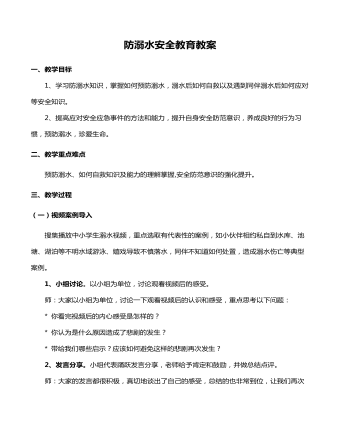
中小学生防溺水安全教育教案
■ 溺水致死的原因溺水致死的原因主要是气管内吸入大量水分阻碍呼吸,或因喉头强烈痉挛引起呼吸道关闭、窒息死亡。另外,溺水致死的原因还包括:1、大量水藻、草类、泥沙进入口鼻、气管和肺,阻塞呼吸道而窒息。2、惊恐、寒冷使喉头痉挛、呼吸道梗阻而窒息。3、淡水淹溺:大量水分进入血液,血液被稀释,出现溶血、血钾升高导致心室颤动、心 跳停止。4、海水淹溺:高钠引起血渗透压升高,造成严重肺水肿,导致心力衰竭而死亡。 ■ 溺水的症状从人体外部特征判断,溺水者面部通常青紫、肿胀、双眼充血,口腔、鼻孔和气管充满血性泡沫;肢体湿冷、上腹胀满、烦躁不安或神志不清、呼吸不规则、脉细弱,甚至抽搐或呼吸、 心跳停止;肺腔一般有积水,内有泥沙或其他水中的杂质。从医学检查判断,溺水者的肺部罗音、心音弱而不整,淡水淹溺者有血液稀释和溶血的表现,海水淹溺者有血液浓缩和高血钾的 表现,严重者会因心跳、呼吸停止而死亡。
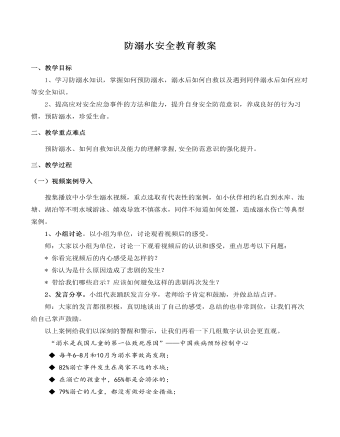
中小学生防溺水安全教育教案 (1)
(一)视频案例导入搜集播放中小学生溺水视频,重点选取有代表性的案例,如小伙伴相约私自到水库、池塘、湖泊等不明水域游泳、嬉戏导致不慎落水,同伴不知道如何处置,造成溺水伤亡等典型案例。1、小组讨论。以小组为单位,讨论观看视频后的感受。师:大家以小组为单位,讨论一下观看视频后的认识和感受,重点思考以下问题:* 你看完视频后的内心感受是怎样的?* 你认为是什么原因造成了悲剧的发生? * 带给我们哪些启示?应该如何避免这样的悲剧再次发生?2、发言分享。小组代表踊跃发言分享,老师给予肯定和鼓励,并做总结点评。师:大家的发言都很积极,真切地谈出了自己的感受,总结的也非常到位,让我们再次给自己掌声鼓励。
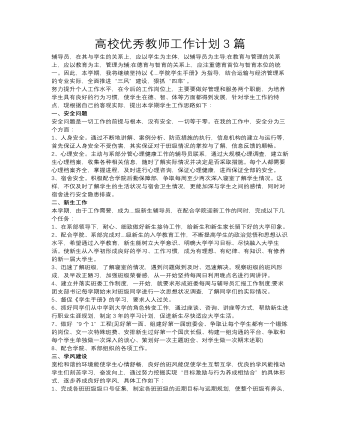
高校优秀教师工作计划3篇
一、安全问题安全问题是一切工作的前提与根本,没有安全,一切等于零。在我的工作中,安全分为三个方面:1、人身安全。通过不断地讲解、案例分析、防范措施的执行,信息机构的建立与运行等,首先保证人身安全不受伤害,其实保证对于班级情况的掌控与了解,信息反馈的顺畅。2、心理安全。主动与系部分管心理健康工作的辅导员联系,通过大规模心理调查,建立新生心理档案,收集各种相关信息,随时了解实际情况并决定是否采取措施。每个人都需要心理档案齐全,掌握进程,及时进行心理咨询,保证心理健康,进而保证全部的安全。3、宿舍安全。积极配合学院后勤保障部,争取每周至少两次深入寝室了解学生情况。这样,不仅及时了解学生的生活状况与宿舍卫生情况,更能加深与学生之间的感情,同时对宿舍进行安全隐患排查。
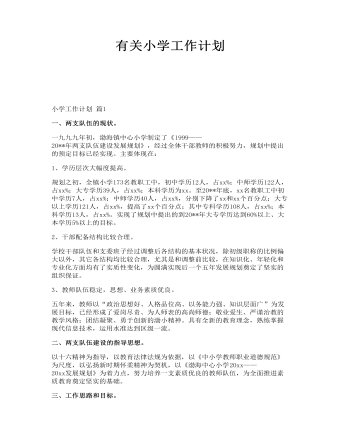
有关小学工作计划
1、学历层次大幅度提高。规划之初,全镇小学173名教职工中,初中学历12人,占xx%;中师学历122人,占xx%;大专学历39人,占xx%;本科学历为xx。至20**年底,xx名教职工中初中学历7人,占xx%;中师学历40人,占xx%,分别下降了xx和xx个百分点;大专以上学历121人,占xx%,提高了xx个百分点;其中专科学历108人,占xx%;本科学历13人,占xx%。实现了规划中提出的到20**年大专学历达到60%以上、大本学历5%以上的目标。2、干部配备结构比较合理。学校干部队伍和支委班子经过调整后各结构的基本状况,除初级职称的比例偏大以外,其它各结构均比较合理,尤其是和调整前比较,在知识化、年轻化和专业化方面均有了实质性变化,为圆满实现后一个五年发展规划奠定了坚实的组织保证。
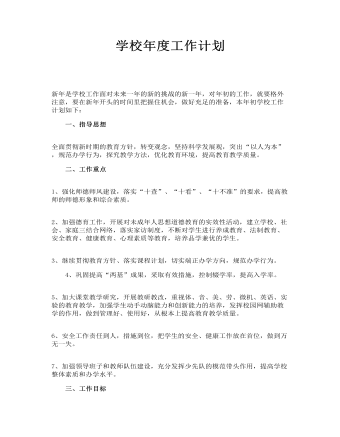
学校年度工作计划
1、强化师德师风建设,落实“十查”、“十看”、“十不准”的要求,提高教师的师德形象和综合素质。 2、加强德育工作,开展对未成年人思想道德教育的实效性活动,建立学校、社会、家庭三结合网络,落实家访制度,不断对学生进行养成教育、法制教育、安全教育、健康教育、心理素质等教育,培养品学兼优的学生。 3、继续贯彻教育方针、落实课程计划,切实端正办学方向,规范办学行为。
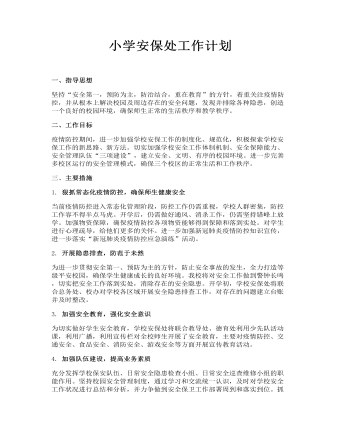
小学安保处工作计划
1. 狠抓常态化疫情防控,确保师生健康安全当前疫情防控进入常态化管理阶段,防控工作仍需重视,学校人群密集,防控工作容不得半点马虎。开学后,仍需做好通风、消杀工作,仍需坚持错峰上放学。加强物资保障,确保疫情防控各项物资能够得到保障和落到实处。对学生进行心理疏导,给他们更多的关怀。进一步加强新冠肺炎疫情防控知识宣传,进一步落实“新冠肺炎疫情防控应急演练”活动。
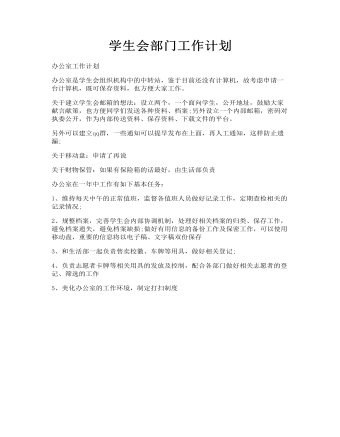
学生会工作计划之办公室
关于财物保管:如果有保险箱的话最好,由生活部负责办公室在一年中工作有如下基本任务:1、维持每天中午的正常值班,监督各值班人员做好记录工作,定期查检相关的记录情况;2、规整档案,完善学生会内部协调机制,处理好相关档案的归类、保存工作,避免档案遗失,避免档案缺损;做好有用信息的备份工作及保密工作,可以使用移动盘,重要的信息将以电子稿、文字稿双份保存
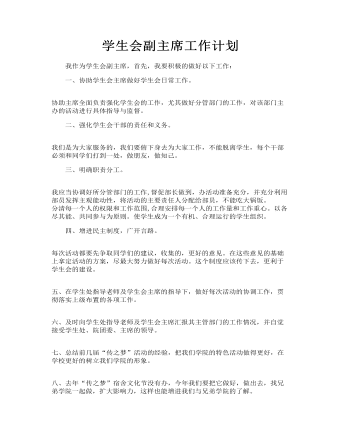
学生会副主席工作计划
三、明确职责分工。 我应当协调好所分管部门的工作,督促部长做到,办活动准备充分,并充分利用部员发挥主观能动性,将活动的主要责任人分配给部员,不能吃大锅饭。 分清每一个人的权限和工作范围,合理安排每一个人的工作量和工作重心。以各尽其能、共同参与为原则。使学生成为一个有机、合理运行的学生组织。

小学课程工作计划
1、保持学生对音乐的兴趣,使学生乐于参与音乐活动。 2、培养音乐感受与鉴赏能力。 3、培养表现音乐的能力。 4、培养艺术想象和创造力。 5、培养乐观的态度和友爱精神

学校工会工作计划
1、加强教代会自身建设,定期召开教代会,认真落实教代会的各项决议,充分发挥教代会和全体教职工的作用,督促学校对教代会提出的提案予以落实和执行。定期组织教代会代表学习,提高教代会代表参政、议政能力。切实保障教职工在教育改革和发展中享有知情权、参与权、决策权和监督权,认真维护和保障教职工的合法权益,支持学校依法行政。
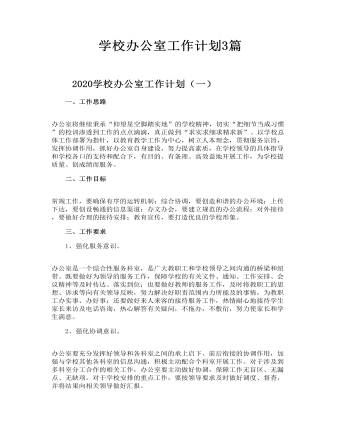
学校办公室工作计划3篇
1、强化服务意识。 办公室是一个综合性服务科室,是广大教职工和学校领导之间沟通的桥梁和纽带。既要做好为领导的服务工作,保障学校的有关文件、通知、工作安排、会议精神等及时传达、落实到位;也要做好教师的服务工作,及时将教职工的思想、诉求等向有关领导反映,努力解决好职责范围内力所能及的事情,为教职工办实事、办好事;还要做好来人来客的接待服务工作,热情耐心地接待学生家长来访及电话咨询,热心解答有关疑问,不拖办,不敷衍,努力使家长和学生满意。